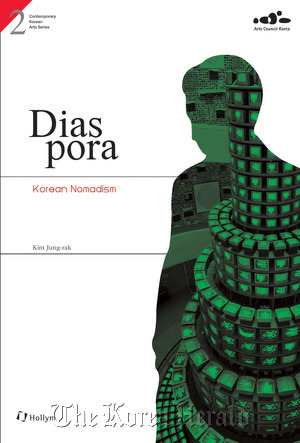
By Kim Jung-rak
(Hollym)
What was it like for late artist Paik Nam-june (1932-2006) to leave his home country and study art overseas?
Scholar Kim Jung-rak’s book, “Diaspora- Korean Nomadism” features the lives of Korea’s nomadic artists who have broken into the international art scene over the past 50 years.
Kim begins the book by introducing the terms “nomadism” and “diaspora,” using them as the main concepts to engage the nomadic experience of the Korean artists in modern times. He explains nomadism as “the act of denying existing, stagnant values and philosophy, and searching or creating something new,” while pointing out that diasporas “do not discriminate among diverse elements but actively take them in and create new cultural fusions.”
Kim deftly applies the concepts to the fascinating lives of the artists, including the famous video artist Paik Nam-june, minimalist painter Lee U-fan, and the pioneering abstract artist Kim Whan-ki.
Among the featured artists, the book dedicates one chapter to Paik, who is considered the founder of video art -- which has become a “key element in the contemporary art history.” Paik, who was born in Seoul in 1932 during the Japanese colonial period, studied in Japan and Germany, and eventually moved to New York City in 1964 -- where he practiced and performed many forms of electronic art.
The book explores how Paik’s nomadic experience and lifestyle have influenced his distinctive artistic style and works, claiming that the artist “chose” diaspora over the traditional. Paik studied a wide variety of subjects during his stay in Japan and Germany, including music composition, history, architecture, and philosophy. Kim points out how Paik’s video works reflect his unique artistic spirit, which resulted from being exposed to diverse cultures and areas of studies.
Artist Lee U-fan has also spent most of his career living in Japan and France, while Kim Whan-ki (1913-1974) lived and worked in Japan, France, and the United States.
The book also offers an interesting analysis of the emergence of the “neo-nomads” movement in the ’70s and ’80s in Korea, which mostly consisted of monochrome abstract works.
The book is one of the four English-language volumes of “Contemporary Korean Arts Series,” which was published by the Arts Council Korea (ARKO) this year.
-
Articles by Korea Herald








![[KH Explains] Hyundai's full hybrid edge to pay off amid slow transition to pure EVs](http://res.heraldm.com/phpwas/restmb_idxmake.php?idx=644&simg=/content/image/2024/04/18/20240418050645_0.jpg&u=20240419100350)







![[From the Scene] Monks, Buddhists hail return of remains of Buddhas](http://res.heraldm.com/phpwas/restmb_idxmake.php?idx=652&simg=/content/image/2024/04/19/20240419050617_0.jpg&u=20240419175937)

![[KH Explains] Hyundai's full hybrid edge to pay off amid slow transition to pure EVs](http://res.heraldm.com/phpwas/restmb_idxmake.php?idx=652&simg=/content/image/2024/04/18/20240418050645_0.jpg&u=20240419100350)

![[Today’s K-pop] Illit drops debut single remix](http://res.heraldm.com/phpwas/restmb_idxmake.php?idx=642&simg=/content/image/2024/04/19/20240419050612_0.jpg&u=)